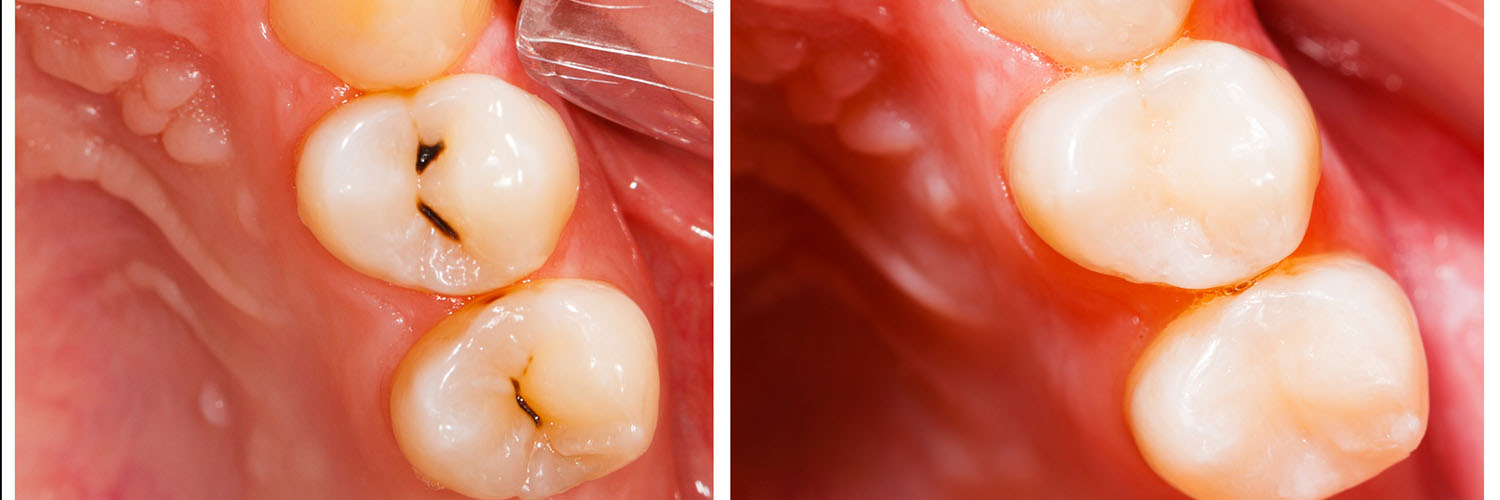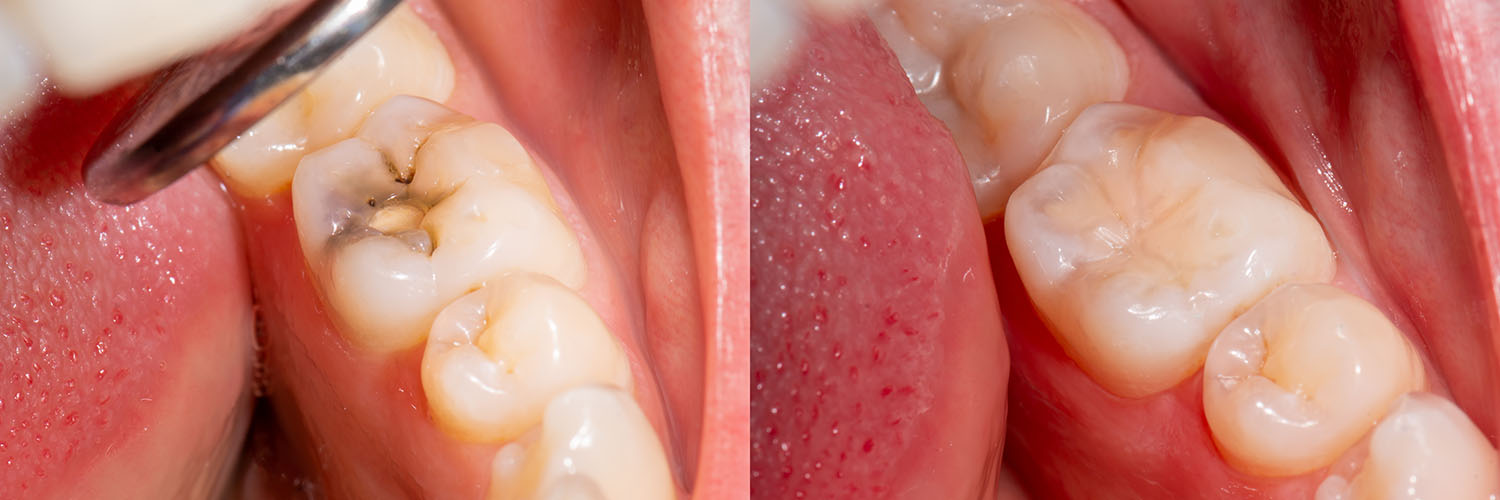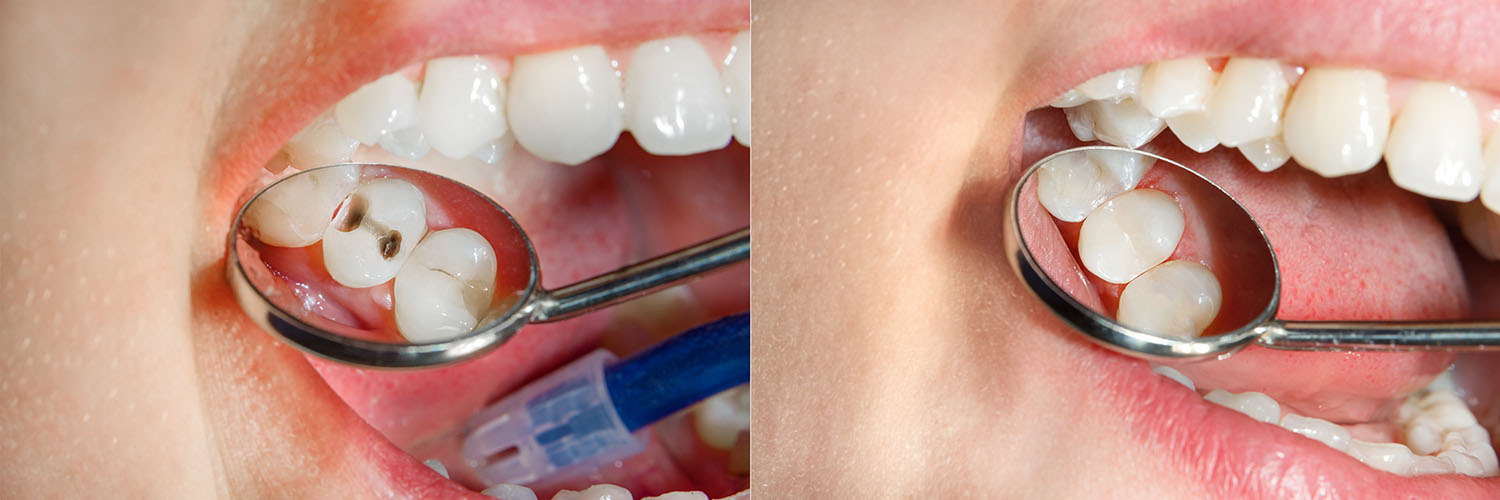We speak English, Spanish and Portuguese
We speak English, Spanish and Portuguese

When a cavity or minor fracture removes natural tooth structure, a filling rebuilds what’s missing so the tooth can perform normally again. Fillings replace lost enamel and dentin, seal out bacteria, and restore chewing surfaces so you can eat and speak without worry.
Tooth decay remains one of the most common oral health issues across all ages, which is why restorative treatments like fillings are among the most frequently performed procedures in general dentistry. The goal is simple: remove infected tissue, preserve as much healthy tooth as possible, and restore a comfortable, functional bite.
At Inspirational Smiles, our approach emphasizes precise technique and modern materials so restorations look natural and last. We take time to explain options, the steps involved, and what you can expect during and after treatment, helping patients make informed decisions about their care.
Humans have tried to repair damaged teeth for thousands of years, and archaeological evidence shows early attempts to fill cavities as far back as ancient civilizations. Over time, materials and methods evolved from rudimentary fillers to the metal and ceramic restorations developed in the modern era.
In the 19th and 20th centuries, alloys such as dental amalgam and gold became widely used because they offered strength and longevity. More recently, advances in dental chemistry and adhesive technology have produced a broader set of options that balance durability with cosmetic appeal.
Today’s tooth-colored restoratives offer many of the strengths of traditional materials while blending seamlessly with the surrounding enamel. That evolution has given clinicians more tools to tailor restorations to a patient’s functional needs and cosmetic goals.
Choosing the right filling material is a clinical decision that takes into account the size and location of the cavity, the patient’s bite forces, esthetic preferences, and long-term oral health goals. Some materials excel in strength and longevity; others are selected for their ability to mimic natural tooth color and translucency.
Our clinicians aim to conserve tooth structure whenever possible. Modern adhesive techniques allow us to secure restorations with minimal removal of healthy enamel and dentin, which helps maintain the tooth’s integrity and reduces the likelihood of future problems.
We’ll review the advantages and limitations of available materials, and recommend the option that best fits your clinical situation and expectations. Our priority is to restore function while producing a result that looks natural and feels comfortable.

Dental technology now offers a wider selection of restorative materials than ever before. Each material has a specific role — some are ideal for back teeth under heavy chewing pressure, while others are better suited for small repairs in visible areas where aesthetics matter most.
Rather than a one-size-fits-all solution, modern dentistry uses materials strategically to achieve a balance of strength, longevity, and appearance. Below are commonly used options and what they generally provide in everyday practice.
Composite resins are a blend of resin and glass or ceramic particles that are bonded directly to the tooth. They are available in a range of shades and can be shaped to match the natural contours of your teeth, making them a popular choice for visible areas.
Because composites bond to the tooth structure, they help reinforce the remaining enamel and dentin. They are placed in a single visit and cured with a light, but may be more prone to gradual wear or staining over many years compared with some indirect options.
Amalgam has a long history of dependable performance and remains a durable option for large restorations in back teeth where appearance is less of a concern. Amalgam is tough under heavy chewing forces and can be a practical solution in certain clinical scenarios.
Glass ionomer materials bond chemically to tooth structure and release fluoride over time, which can be protective in high-risk situations. They are often used for small cavities near the gumline, for pediatric restorations, or as temporary solutions where a longer-term restoration will follow.
Ceramic restorations are fabricated outside the mouth and then bonded into place. Porcelain and other ceramic materials are highly resistant to staining and wear, and they provide excellent aesthetics and fit when restoring larger areas of a tooth.
Because they are made in a laboratory or with in-office milling technology, ceramics often require two visits or same-day CAD/CAM workflows for fabrication and placement.
Gold and other precious metals are less common today but still valued for their longevity and biocompatibility. Metal restorations can offer excellent wear characteristics and a predictable lifespan in certain situations, particularly when maximum strength is required.

The process starts with a thorough evaluation: visual exam, digital X-rays if needed, and a discussion of treatment options. Once a plan is agreed upon, the clinician prepares the tooth by removing decay and shaping the cavity so the restoration will fit securely and function properly.
Most fillings are placed under local anesthesia to ensure comfort. Depending on the tools and techniques used, removal of decay may involve conventional rotary instruments, air abrasion, or laser technology. The choice of instrument depends on the cavity’s size, location, and the clinician’s judgment.
For direct restorations like composites or glass ionomer, the material is placed and cured in layers, then shaped and polished to match the tooth’s anatomy. For indirect restorations such as inlays or onlays, impressions or digital scans are used to fabricate a precisely fitting piece that is bonded to the tooth at a subsequent visit.
Throughout the procedure, attention to isolation, adhesion protocols, and occlusal (bite) adjustments helps ensure the restoration performs well and feels natural. If you have dental anxiety, we can discuss options to make the visit more comfortable, including relaxation techniques and sedation choices when appropriate.
After a filling is placed, most patients return to normal activities quickly. There may be some temporary numbness from local anesthesia and short-lived sensitivity to temperature or pressure as the tooth settles. These sensations typically decrease over days to weeks.
To protect a new restoration, maintain a consistent at-home routine of brushing with fluoride toothpaste, daily flossing, and avoiding aggressive habits like chewing ice or using teeth as tools. Routine dental checkups and professional cleanings help monitor restorations and identify wear or recurrent decay early.
Occasionally, a filling may require adjustment if the bite feels high or if sensitivity persists. If you experience increasing pain, a prolonged change in bite, or other concerning symptoms, contact the dental team for an evaluation so any necessary corrections can be made.
Protect numb tissues
Wait until sensation returns before eating to avoid accidentally biting your lip or tongue.
Expect mild sensitivity
Temperature or pressure sensitivity is common but should settle. If it increases or lasts beyond a few weeks, schedule an assessment.
Practice gentle hygiene
Brush and floss around the restored tooth, taking care not to disturb the area immediately after treatment if a temporary material was used.
Monitor restoration longevity
With good oral hygiene and routine care, restorations can last many years; however, they may eventually need repair or replacement due to normal wear or changes in the tooth.
We are committed to providing clear information and high-quality care so you can make confident choices about restorative treatment. If you would like to learn more about options for repairing a tooth or whether a filling is the right solution for you, please contact us for more information.


If the pleasure of eating a delicious bowl of ice cream or sipping a soothing cup of tea gets overshadowed by dental pain that makes you wince; it's time to contact our office. As skilled providers of care, we'll determine what's causing your discomfort and perform the treatment required to alleviate your symptoms and get you back on the road to oral health.
Cavities develop because of an infectious process that causes progressive damage to tooth structure. Despite starting as a pinpoint defect on the outermost enamel layer of your tooth, untreated dental decay progressively compromises more and more healthy tooth structure as it works its way to the inner layers of your tooth.
Yes, you can still develop tooth decay on other surfaces of the tooth, around the margins of an old filling, or in fewer instances, recurrent decay underneath it. For this reason, it's essential to maintain excellent oral hygiene, a diet low in sugary beverages and sweets, and be sure to visit our office for routine checkups and care. While tooth decay is second only to the common cold in frequency, it's almost entirely preventable.
We value the time and comfort of our patients. If cavities are located on adjacent teeth, or in the same section of your smile, it may be possible to treat more than one tooth during your visit. However, how much is done each visit depends on several factors. We keep our patients well informed and tailor every treatment plan and visit to address their unique needs.
Addressing concerns on the presence of elemental mercury in silver fillings, the American Dental Association (ADA), The Center for Disease Control and Prevention (CDC), the FDA, and the World Health Organization have all stated that amalgam restorations do not pose a risk to health. However, individuals with allergies or sensitivities to the metals in dental amalgam are advised to pursue other restorative options.
Dental fillings are performed under local anesthesia to help ensure your comfort throughout the entire procedure. The involved tooth remains completely numb for the extent of your visit. Within one or two hours after the procedure is completed, the local anesthetic will gradually wear off, and normal sensations return.
A tooth-colored composite filling is fully hardened and set by the end of your visit. However, we may advise you to wait a couple of hours until the local anesthesia has completely worn off. This advice is to help ensure you don't accidentally bite your lip, cheek, or tongue while still numb.
The lifetime of a dental filling varies depending on the type of material used. While popular dental materials can last a decade or more with proper care, they can degrade over time, wear down, or even break. When this happens, you may experience some tooth sensitivity, a jagged edge, or a loose or dislodged piece of filling material. Whatever the case may be, it's essential to get the filling replaced before the tooth sustains further damage or other consequences arise. Beyond taking good care of your smile to help ensure the longevity of your fillings, our office regularly checks the status of your existing fillings as part of a routine checkup exam.
Dental fillings are an essential investment that serves to preserve and protect the health of your smile. With that said, how much a filling costs depends on the number of surfaces of the tooth involved and the filling material that is used. Amalgam restorations are the most economical. While tooth-colored composite fillings have a slightly higher cost, they offer the added benefits of being metal-free and much more aesthetically pleasing. Ceramic fillings, inlays, and onlays are more expensive than the preceding options but provide outstanding, long-lasting, and natural-looking results.
Dental insurances typically cover the cost of dental fillings. While we work with you to maximize your insurance benefits, there may still be an out-of-pocket expense. At the office of Inspirational Smiles, we strive to help you begin care without any additional financial stress or delay.
Dental fillings are restorative materials used to rebuild tooth structure lost to decay or minor fractures. They seal the cavity to prevent bacteria from re-entering and help restore the tooth's normal shape and function. By replacing missing enamel and dentin, fillings allow patients to chew and speak without discomfort or altered bite mechanics.
The process begins with removal of the infected tooth tissue and shaping the cavity so the restoration fits securely. Modern adhesive techniques bond many filling materials to remaining tooth structure, which can help reinforce the tooth. The overall goal is to preserve natural tooth structure while restoring comfort, function and a natural appearance.
Tooth-colored composite resins are blends of resin and glass or ceramic particles that bond directly to the tooth and can be shaded to match adjacent enamel. Composites are commonly used in visible areas and for conservative repairs because they can be placed in a single visit and shaped to restore natural contours. They may require maintenance over time due to gradual wear or staining compared with some indirect options.
Traditional amalgam restorations are metal alloys known for strength and durability, making them suitable for large restorations on posterior teeth where appearance is less critical. Glass ionomer cements bond chemically to tooth structure and release fluoride, which can be helpful in high-risk situations or pediatric dentistry. These materials are often chosen for specific clinical needs such as restorations near the gumline or temporary repairs.
Ceramic inlays and onlays are fabricated outside the mouth and then bonded to the tooth, offering excellent aesthetics and resistance to staining for larger or more complex restorations. Precious metal restorations such as gold are less common today but remain valued for longevity and biocompatibility in certain cases. Your clinician will explain the strengths and trade-offs of each material so that the selection fits your functional demands and esthetic priorities.
Choosing a filling material is a clinical decision that considers the cavity's size and location, the patient's bite forces, esthetic concerns and long-term oral health goals. Teeth in the back of the mouth endure greater chewing forces, so materials with higher wear resistance may be prioritized in those areas. For front teeth or other visible locations, color-matching and translucency become more important to achieve a natural look.
The clinician also evaluates how much healthy tooth structure can be preserved and whether an adhesive direct restoration or an indirect fabricated piece is the better option. Patient preferences, habits such as grinding or chewing hard foods, and any history of sensitivity factor into the recommendation. A clear discussion of benefits and limitations helps patients make informed choices that balance durability and appearance.
A filling appointment starts with a thorough evaluation that may include a visual exam and digital X-rays to determine the extent of decay and check surrounding tooth structure. The clinician will review treatment options and develop a plan that preserves as much healthy tooth as possible while ensuring a secure restoration. Once a plan is agreed upon, the area is prepared for treatment by isolating the tooth and removing decayed tissue.
Most fillings are placed under local anesthesia to ensure patient comfort during decay removal and restoration placement. Depending on the situation, decay may be removed with rotary instruments, air abrasion or laser technology, and the cavity is shaped to receive the chosen material. For direct restorations the material is placed in layers and cured; for indirect restorations impressions or digital scans are taken for fabrication.
After placement, the restoration is shaped and polished and the bite is checked and adjusted as needed to ensure proper occlusion and comfort. Appropriate adhesion protocols and isolation techniques are employed to maximize the restoration's performance and longevity. During the visit your clinician will explain aftercare and answer any questions so you leave with a clear understanding of next steps and expectations at Inspirational Smiles.
Most patients experience little to no pain during a filling because local anesthesia is used to numb the tooth and surrounding tissues before work begins. The injection itself may produce a brief pinch or pressure, but modern techniques and topical anesthetics help minimize discomfort. For particularly anxious patients or complex procedures, clinicians can discuss additional comfort measures to make the visit more tolerable.
After the appointment, it is common to feel temporary numbness and mild sensitivity to temperature or pressure as the tooth settles. These sensations usually diminish over days to weeks and can be managed with over-the-counter analgesics when appropriate. If sensitivity or pain increases or persists, contact the dental team for an evaluation so any necessary adjustments can be made.
The lifespan of a filling depends on the material used, the size and location of the restoration, the patient's bite forces and oral hygiene habits. Small composite fillings in low-stress areas may last many years, while larger restorations under heavy chewing forces may show wear sooner. Regular dental checkups allow clinicians to monitor restorations and detect early signs of wear or recurrent decay.
Other factors that influence longevity include bruxism, diet, and the amount of remaining natural tooth structure supporting the restoration. Proper oral hygiene and avoidance of habits like chewing ice or using teeth as tools can help extend the functional life of a filling. When wear, fracture, or recurrent decay occurs, the restoration can be repaired or replaced depending on the situation.
Immediately after a filling, protect numb tissues by waiting until sensation returns before eating to avoid biting your cheek, lip or tongue. Expect mild sensitivity to hot, cold or pressure that typically subsides within days to weeks, and follow any specific instructions given by the clinician regarding eating, oral hygiene or temporary materials. If a bite feels uneven or sensitivity worsens, contact the practice for a follow-up evaluation.
Long-term care for restorations centers on consistent oral hygiene, including brushing with fluoride toothpaste and daily flossing to prevent recurrent decay at the margins. Regular professional cleanings and examinations allow the dental team to monitor restorations and address issues early. Maintaining a balanced diet and avoiding hard or sticky foods that stress the restoration can also prolong its service life.
Minor defects such as small chips, marginal breakdown or localized staining can often be repaired without removing the entire restoration, depending on the material and extent of the damage. Composite fillings are particularly amenable to localized repair because new composite can be bonded to existing material when appropriate. The clinician will assess whether a repair will restore function and seal the tooth effectively or if replacement is the safer long-term option.
When a restoration has extensive fracture, recurrent decay beneath the filling, or compromised tooth structure, an indirect restoration such as an inlay, onlay or crown may be recommended. Those options provide greater structural support for heavily restored teeth and can reduce the risk of further damage. The treatment choice aims to preserve as much natural tooth as possible while restoring durability and function.
Common, generally manageable issues after a filling include short-term sensitivity to temperature or pressure, an uneven bite that requires adjustment, and, over time, wear or marginal leakage that can lead to recurrent decay. Occasionally a filling may fail due to fracture or breakdown at the edges, which is why regular monitoring is important. If symptoms such as persistent or worsening pain, swelling, or prolonged sensitivity occur, prompt evaluation is necessary to address potential complications.
Allergic reactions to restorative materials are uncommon but possible, and clinicians will review material composition when there is a known sensitivity. Concerns about specific materials, such as amalgam, should be discussed openly with your provider so the best material is selected based on clinical needs and medical history. Overall, careful technique and appropriate material selection minimize risks and support predictable outcomes.
Fillings should be examined during routine dental checkups, typically every six months or according to your clinician's recommended schedule, so the team can assess wear, margins and the health of the underlying tooth. Digital X-rays and visual evaluation help detect recurrent decay or changes that are not visible to the naked eye. Regular monitoring enables timely intervention before small problems become more extensive.
If you notice increased sensitivity, a persistent change in bite, a rough or broken edge, discoloration around the filling, or any sharp pain when biting, schedule an appointment promptly for evaluation. At Inspirational Smiles we encourage patients to report these signs early so restorations can be repaired or replaced before the issue progresses. Early attention helps preserve tooth structure and maintain long-term oral health.

Looking to schedule your next dental visit or learn more about our services?
Getting in touch with Inspirational Smiles is simple! Our caring team is ready to help with appointment scheduling, questions about treatments, or any concerns you may have. You can call us or use our easy online contact form—whatever works best for you.
Take the first step toward a healthier, more confident smile today and experience the difference that personalized, compassionate dental care can make.